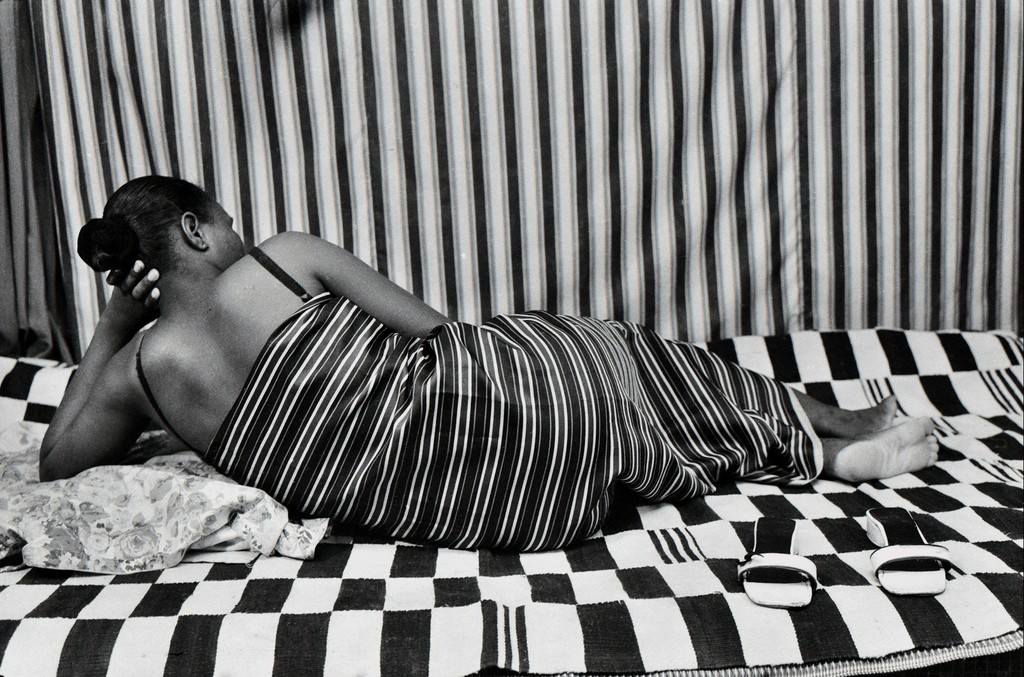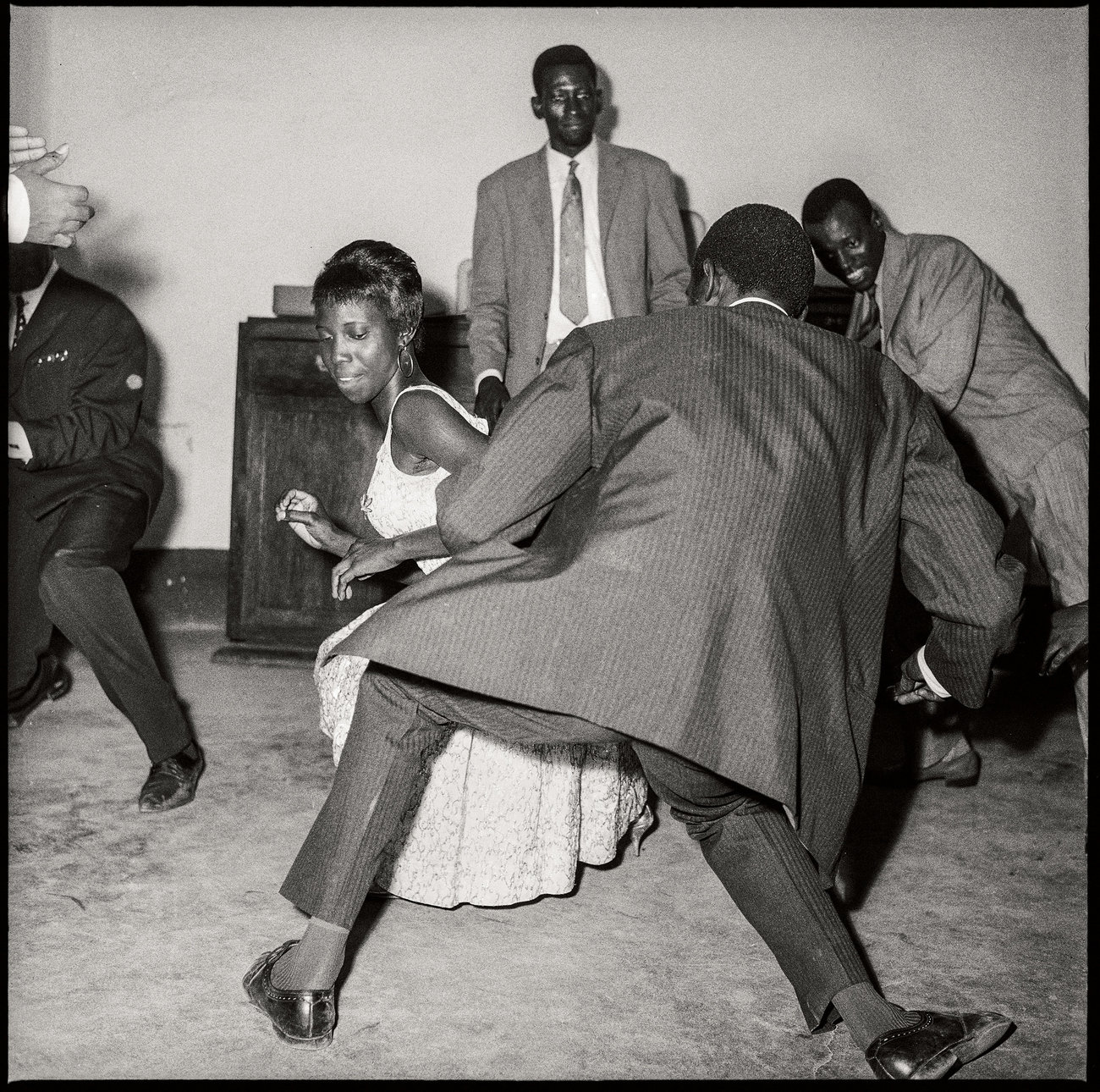Dansez le Twist
by Allison Moore

Malick Sidibé. Vues de Dos—Juin. Late 1990s. Collezione Maramotti, Reggio Emilia, Italy. © Malick Sidibé.
The Malian photographer Malick Sidibé, who died in 2016 at the age of 80, was best characterized by his immense joie de vivre. The man was happy. His joy shines through in his spunky portraits, often shot against a background of jazzy stripes, of hundreds of thousands of people: Bamako locals, visitors from rural villages, foreign travelers passing through this cosmopolitan west African capital. They posed in their finest attire and their disco duds, with goats, boomboxes, and guitars: emblems of prestige or modernity, currency of cool. He snapped men wearing cowboy hats or smoking cigarettes, imitating outlaws from American westerns and the antiheroes of French cinema. Babies posed before bulges of patterned cloth, hiding invisible mothers holding them still. Unmarried women with Afros and short skirts, married women in headscarves and sharply tailored dresses, couples celebrating their union or an afternoon off: all appear in their best light in his pictures. Borrowing props and clothes, they dreamed up future selves for the camera. The images served as wish fulfillments as well as memories.
Born to a Fulani family in Soloba, southern Mali, Sidibé entered the colonial art school in Bamako and earned a jeweler’s degree in 1955. Invited to decorate a French photographer’s studio, he learned the trade and opened Studio Malick in 1962, two years after Mali’s independence from France — one of dozens of photography studios to open in the heady first days after colonial rule. Mali in the early 1960s was a socialist one-party state, and its authorities encouraged a reactionary cultural nationalism. But a wave of youthful rebellion, influenced by new- found freedom and enamored of global fashion, crests in the portraits Sidibé and his apprentices took at parties and on the beach.

Sidibé first used a Brownie Flash, then an Agfa 6×6 with bellows and a Foca Sport 24×36. As he tells it, his appearance at parties conferred prestige, and he loved to go out, hitting at least four or five parties a night, and then printing in the wee morning hours. He displayed the photos outside the studio on Monday for his young customers to shop. Merengue Dancer (1964) shows a man spectacularly grooving at a house party, caught between patterned curtains, a woman laughing in the background. Just in frame, disembodied hands clap in a flutter of appreciation and response. Popular music at parties ranged from west African yé-yé to its dance forms in the diaspora, including Afro-Cuban music and American rock ‘n’ roll. Clubs, or grins, of like-minded youth hosted dances despite strict curfews. Expected to adhere to old-fashioned traditions and strict religious norms, Bamakois youth rebelled, adopting what the Malian scholar Manthia Diawara calls a “diaspora aesthetic.” Sidibé’s camera immortalized that era.
In the 1980s, with the arrival of Korean color labs in west Africa, Sidibé’s portraiture business began to lag, and for a time he focused on repairing cameras. But in the early 1990s, a curator came to Bamako, looking for the photographer Seydou Keïta, and found Sidibé en route. Both were exhibited in Paris and New York, and the world at last became acquainted with Malian studio photography. 1994 saw the first Bamako Photography Biennale (now called the Rencontres africaines de la photographie), which continues to have a profound impact on African image-making. Sidibé taught students at the city’s new photography schools — including women, noteworthy in this patriarchal, Muslim nation — and showed younger photographers’ works alongside his own.

He remains best known for his commercial portraiture, but Sidibé also explored fashion and art photography. In his Vues de dos, or “Back Views,” series, paid models wearing striped or patterned dresses, or family members in rigorous mise-en-scène, appear with their backs turned against similarly graphic backdrops. Vues de dos has received less critical attention than it deserves, as too few have credited Sidibé for melding the aesthetic of Mande culture with the values of studio portraiture, all reconfigured to address an international audience. For non-Malians, they are more opaque than his shots of partiers and fashion plates, and yet the absence of faces pushes a little on local values, too. This gentle twist is not the avant-gardism of an alienated, bohemian spirit. It is rooted in the Mande values of a communal self, of an aesthetic that responds to change and keeps up to date without losing its connection to the past: a rhythmic aesthetic, one of slow transformation through repetition and slight variation.
In Mande culture, he was a hero. He achieved fame and prestige for his nation, with such prizes as the Venice Biennale’s Golden Lion, and he left a tremendous photographic legacy for posterity. Through it all, Sidibé remained fun-loving, generous, and good-spirited, and the fortune brought by his camera went largely to care for his large family, neighbors, and friends. Allah ka dayoro sumaya — may God cool his resting place.